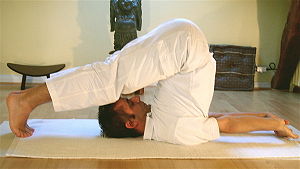Note: This is a project under development. The articles on this wiki are just being initiated and broadly incomplete. You can Help creating new pages.
Halasana
Revision as of 17:38, 23 November 2016 by Jayashree (talk | contribs) (Created page with "thumb|right|''Halasana'' Halasana (/hʌˈlæsʌnʌ/;[1] Sanskrit: हलासन; IAST: Halāsana) or Plow Pose is an asana. == Etymology == The name...")
Halasana (/hʌˈlæsʌnʌ/;[1] Sanskrit: हलासन; IAST: Halāsana) or Plow Pose is an asana.
Etymology
The name comes from the Sanskrit words hala (हला) meaning "plow" and asana (आसन) meaning "posture" or "seat".
Description
The practitioner lies on the floor, lifts the legs, and then places them behind the head. Experienced practitioners may enter Halasana from a standing position by tucking chin to chest, placing hands on the floor, walking the feet towards the hands and bending at the elbows to lower shoulders to the floor.
Health Benefits
- Stretches all muscles and ligament in the practitioner's calves and thighs, resulting in greater leg flexibility
- Therapeutic for leg cramps
- Stimulates the practitioner's thyroid, parathyroid, throat, lungs and abdominal organs
- Helps relieve gas and upper/lower back pain or discomfort
- Promotes good digestion
- Stretches the practitioner's shoulders and spine
- Therapeutic for menopause, infertility, insomnia, headache and sinusitis
- Relieves stress and fatigue
